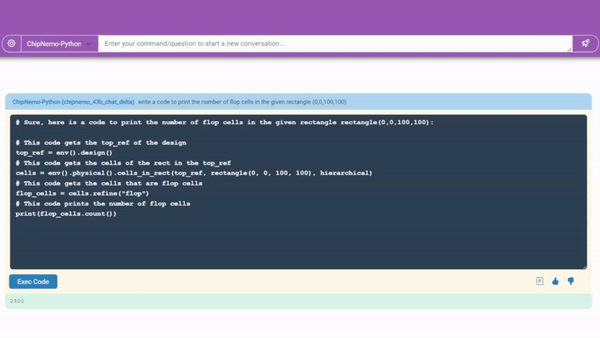NVIDIA has released a groundbreaking research paper demonstrating how generative artificial intelligence (AI) can revolutionize semiconductor design. The study reveals that large language models (LLMs) can benefit specialized fields like chip design. NVIDIA’s custom LLM called ChipNeMo, developed using the NVIDIA NeMo framework, has already shown promising results in tasks like software generation and bug tracking. The company aims to apply generative AI to all stages of chip design in the future. This research contributes to NVIDIA’s broader efforts in using AI for various applications, from self-driving cars to circuit optimization.

**NVIDIA Utilizes Generative AI to Design Semiconductors: ChipNeMo**
A groundbreaking research paper released by NVIDIA demonstrates the game-changing potential of generative artificial intelligence (AI) in semiconductor design. This research highlights how even specialized fields like semiconductor design can benefit from large language models (LLMs).
Designing advanced chips like NVIDIA’s H100 Tensor Core GPU is an intricate task involving billions of transistors and extreme precision. It typically takes multiple engineering teams up to two years to complete. These teams work on various aspects such as architecture, circuit placement, and testing using specialized methods and software.
NVIDIA believes that large language models will significantly enhance all chip design processes over time and help streamline the entire workflow. They presented this research at the International Conference on Computer-Aided Design, a crucial event for engineers in the electronic design automation (EDA) field.
To aid their internal processes, NVIDIA engineers developed a custom LLM called ChipNeMo. This model, trained on NVIDIA’s proprietary data, assists in tasks like software generation and analysis. The company aims to extend the application of generative AI to all stages of chip design. Successful initial use cases include a chatbot that helps engineers find technical documents and a tool for bug tracking.
NVIDIA used their NVIDIA NeMo framework, part of the NVIDIA AI Enterprise software platform, to build ChipNeMo. The model started with a base of 43 billion parameters and underwent training on more than a trillion tokens. It also received further training on internal data and mixed examples.
Key insights from the research indicate that custom LLMs like ChipNeMo perform on par with or even better than general-purpose models, despite being smaller. Proper selection and preparation of data for training were highlighted as crucial factors.
NVIDIA’s foray into AI for semiconductor design is part of their broader research efforts, with hundreds of scientists worldwide working on various topics, including AI and self-driving cars. This research complements other projects that utilize AI to design faster and smaller circuits and optimize block placements.
To harness the power of AI and stay competitive, companies can follow these steps:
1. Identify Automation Opportunities: Locate key customer interaction points that can benefit from AI.
2. Define KPIs: Ensure your AI initiatives have measurable impacts on business outcomes.
3. Select an AI Solution: Choose tools that align with your needs and offer customization.
4. Implement Gradually: Begin with a pilot, collect data, and gradually expand AI usage.
For AI KPI management advice, connect with us at hello@itinai.com. Stay updated on leveraging AI insights through our Telegram channel t.me/itinainews or Twitter @itinaicom.
**Spotlight on a Practical AI Solution: AI Sales Bot**
Consider using the AI Sales Bot from itinai.com/aisalesbot to automate customer engagement 24/7 and manage interactions throughout the customer journey. Discover how AI can redefine your sales processes and customer engagement. Explore solutions at itinai.com.
List of Useful Links:
- AI Lab in Telegram @aiscrumbot – free consultation
- NVIDIA Utilizes Generative AI to Design Semiconductors: ChipNeMo
- GreatAIPrompts: AI Prompts, AI Tools & AI News
- Twitter – @itinaicom



























